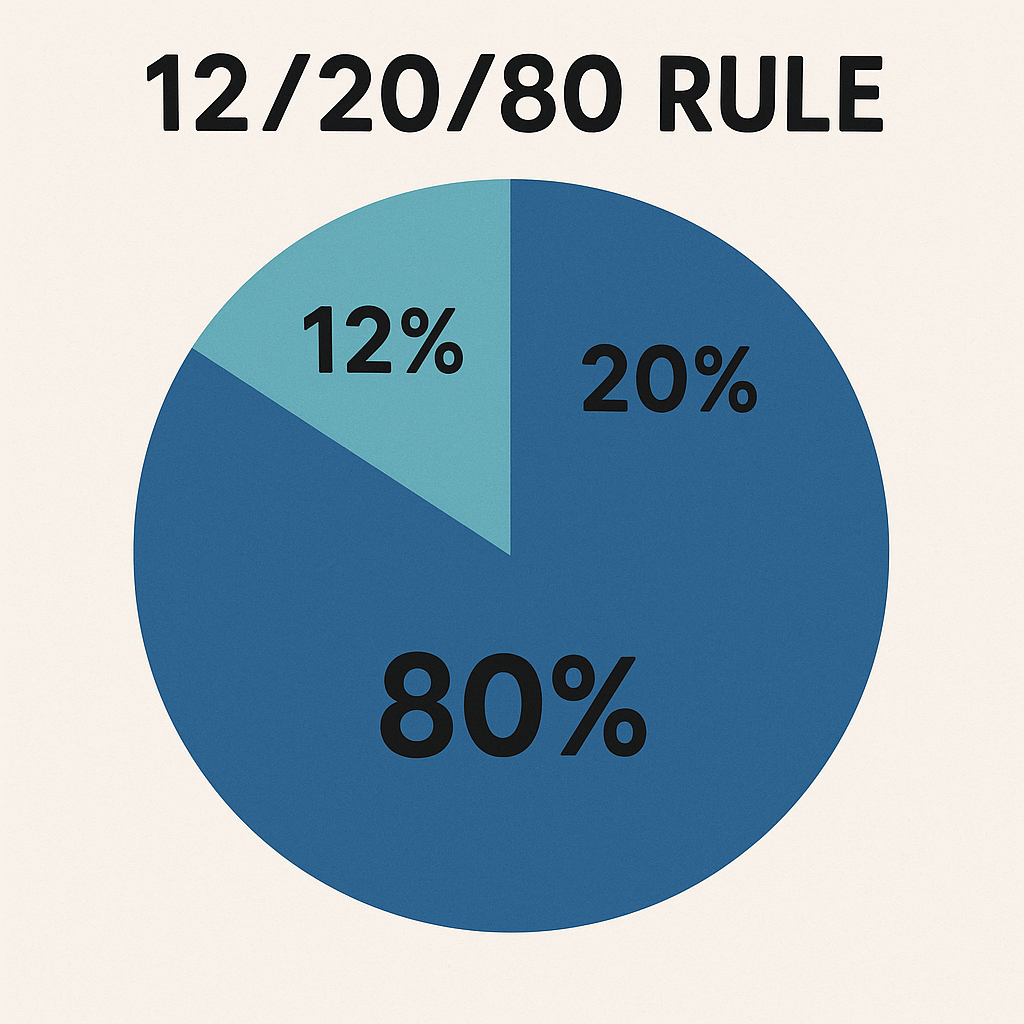June 15, 2025
Do you feel like you’re always busy but never productive? You’re not alone. Millions struggle with managing their time effectively. The solution might be simpler than you think – the 12/20/80 rule. This powerful productivity strategy combines time management with smart prioritization to help you achieve more in less time.

In this comprehensive guide, we’ll break down everything you need to know about the 12/20/80 rule. You’ll learn what it is, where it came from, how to implement it, and why it works so well. By the end, you’ll have a complete framework to revolutionize your productivity.
What Exactly Is the 12/20/80 Rule?
The 12/20/80 rule is a productivity framework that combines three powerful concepts into one streamlined approach:
- 12-hour structured workday – Maximizing productive hours without burnout
- 20% high-impact tasks – Identifying the vital few tasks that drive results
- 80% outcome focus – Leveraging the Pareto Principle for maximum efficiency
This rule isn’t about working harder – it’s about working smarter by focusing on what truly moves the needle in your work and life.
The Science Behind the 12/20/80 Rule
This rule combines two well-established productivity principles:
- The 12-hour productivity window: Research shows that humans have about 12 hours of potential productive time daily when accounting for natural energy fluctuations (National Sleep Foundation)
- The Pareto Principle: The famous 80/20 rule proven across multiple fields, from economics to software development
When combined, these concepts create a powerful system for peak performance.
Breaking Down the 12/20/80 Rule Components
Let’s examine each element of the 12/20/80 rule in detail to understand how they work together.
1. The 12-Hour Productive Day
Contrary to popular belief, the 12-hour component doesn’t mean non-stop work. It’s about structuring your waking hours for maximum effectiveness:
- 6-8 hours of focused, deep work
- 2-3 hours for meetings, communication, and administrative tasks
- 1-2 hours for learning and skill development
- Built-in breaks to maintain energy and focus
Real-world example: Many successful CEOs like Tim Cook and Indra Nooyi follow similar schedules, starting early and structuring their days strategically.
2. The 20% High-Impact Activities
This is where the magic happens. The 12/20/80 rule requires you to:
- Identify which 20% of your tasks generate 80% of your results
- Ruthlessly prioritize these tasks
- Minimize or eliminate low-value activities
Common high-impact activities include:
- Revenue-generating tasks for entrepreneurs
- Client acquisition for sales professionals
- Content creation for marketers
- Strategic planning for executives
3. The 80% Results Focus
This component ensures you’re always working on the right things. By tracking where your results actually come from, you can:
- Stop wasting time on unproductive activities
- Double down on what works
- Continuously refine your 20% focus areas
Step-by-Step Guide to Implementing the 12/20/80 Rule

Now that you understand the theory, let’s make it practical. Here’s exactly how to implement the 12/20/80 rule in your daily routine.
Step 1: Conduct a Time Audit
Before you can apply the rule, you need data. Track your time for 3-5 days using:
- Time tracking apps like Toggl Track
- Simple spreadsheets
- The old-fashioned pen and paper method
Look for patterns in where your time actually goes versus where you think it goes.
Step 2: Identify Your 20%
Analyze your time audit to find:
- Which activities produce the most significant results?
- What tasks make you feel most accomplished?
- Where do you see the highest ROI on your time?
Pro tip: If you’re struggling to identify your 20%, ask yourself: “If I could only do 3 things today, what would they be?”
Step 3: Structure Your 12-Hour Day
Create a daily template that includes:
- Morning (4 hours): Deep work on high-priority tasks
- Midday (4 hours): Meetings, calls, and operational work
- Afternoon (4 hours): Learning, planning, and strategic thinking
Remember to include:
✅ 5-10 minute breaks every 90 minutes
✅ A proper lunch break
✅ Buffer time between tasks
Step 4: Eliminate the 80% Waste
This is often the hardest but most rewarding step. Start by:
- Delegating low-value tasks
- Saying no to unnecessary commitments
- Automating repetitive work
- Batching similar activities
Advanced Applications of the 12/20/80 Rule
Once you’ve mastered the basics, try these advanced techniques:
1. The 12/20/80 Work Week
Apply the same principles to your weekly schedule:
- 12 hours/week on your most important project
- 20% of days dedicated to strategic work
- 80% of results from 2-3 key weekly initiatives
2. Team Implementation
The 12/20/80 rule works exceptionally well for teams when you:
- Align everyone on the 20% priorities
- Structure collaborative work in the most productive hours
- Regularly review what’s actually producing results
3. Personal Life Application
The rule isn’t just for work. Try applying it to:
- Fitness (focus on the 20% of exercises that give 80% of results)
- Relationships (identify the 20% of interactions that matter most)
- Personal finance (find the 20% of expenses causing 80% of your spending)
Common Pitfalls and How to Avoid Them
Even the best systems can fail if implemented incorrectly. Watch out for these mistakes:
1. Overworking
The 12-hour day includes breaks and personal time. Don’t confuse this with working 12 straight hours.
Solution: Use time blocking to ensure balance.
2. Misidentifying Priorities
It’s easy to mistake urgent tasks for important ones.
Solution: Regularly review your 20% with the Eisenhower Matrix
3. Neglecting Energy Management
Your energy fluctuates throughout the day.
Solution: Schedule demanding tasks during your personal peak hours.
Tools to Supercharge Your 12/20/80 Implementation
Enhance your productivity with these recommended tools:
- Time Tracking: RescueTime
- Task Management: ClickUp
- Focus Aid: Forest App
- Automation: Zapier
For more performance-enhancing strategies, explore these WealthLark resources:
FAQs About the 12/20/80 Rule
Q1: Is the 12/20/80 rule the same as the Pareto Principle?
A: While related, they’re not identical. The Pareto Principle (80/20 rule) states that 80% of results come from 20% of efforts. The 12/20/80 rule expands this by adding the 12-hour structured workday component, creating a complete productivity system. It’s like comparing a single tool to an entire toolkit.
Q2: Won’t working 12 hours daily lead to burnout?
A: The key misunderstanding is that these 12 hours include all waking activities – not just work. Properly implemented, the schedule includes:
- 4-6 hours of deep work
- 3-4 hours of administrative tasks
- 2-3 hours for learning/development
- Regular breaks and meals
This balanced approach actually prevents burnout by creating structure, much like how proper tax planning prevents financial stress.
Q3: How do I identify my true 20% high-value activities?
A: Follow this 3-step process:
- Track all activities for 3-5 days using apps like Toggl
- Analyze which tasks actually drive results (revenue, growth, opportunities)
- Consult metrics – if you’re in sales, check which clients generate most revenue (similar to analyzing the 5 Cs of credit)
Q4: Can this rule work for team environments?
A: Absolutely! Team implementation involves:
- Aligning on group priorities (what’s the team’s 20%)
- Structuring collaborative work in productive hours
- Regular reviews of what’s actually producing results
Many successful companies use variations of this, just as smart investors use wealth building strategies.
Q5: How long before I see results from this method?
A: Most users report noticeable improvements within:
- 1-2 weeks: Better task clarity
- 3-4 weeks: Increased productivity
- 2-3 months: Significant outcome improvements
It’s like building passive income – the system compounds over time.
Q6: What if my job requires constant reactivity (like customer service)?
A: Adapt the rule by:
- Batching reactive work into specific time blocks
- Identifying the 20% of issues causing 80% of problems (and solving them permanently)
- Protecting at least 2-3 hours daily for proactive, high-value work
Q7: How does this compare to other productivity methods?
The 12/20/80 rule uniquely combines:
✔ Time management (like Pomodoro)
✔ Priority focus (like Eisenhower Matrix)
✔ Results measurement (like OKRs)
Making it more comprehensive than standalone techniques.
Q8: Can I use this for personal life too?
A: Absolutely! Many apply it to:
- Fitness: 20% of exercises yielding 80% results
- Relationships: Focusing on most meaningful connections
- Finances: Like identifying tax loopholes that save the most money
Q9: What’s the biggest mistake beginners make?
A: Overcomplicating the system. Start simple:
- Just track your time for a few days
- Identify 2-3 obvious high-value tasks
- Protect time for those tasks
Then refine as you go – similar to approaching stock market investments.
Q10: Where can I learn more about advanced applications?
For deeper dives, we recommend these WealthLark resources: